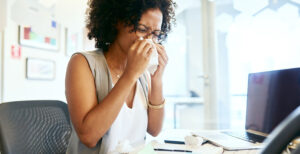Bacillus Globigii, also known as hay bacillus, is a common type of bacterial mold that can be found indoors. Hay bacillus is considered “the best studied Gram-positive bacterium and a model organism to study bacterial chromosome replication and cell differentiation.” It’s a filamentous, spore-forming bacterium that is present in dust, soil, some cleaning products, decomposing organic matter, and even in the intestinal track of animals and people. Although it’s not a toxic or deadly mold, hay bacillus can cause health problems, especially for people with weakened immune systems.
How to Identify Bacillus Globigii
Identifying hay bacillus can be difficult since it looks like most other molds. Typically, it has a circular, flat light-colored growth that is a bit fuzzy when seen up close. Additionally, it can release an indicating scent of earth or musty odor, so it’s important to check for any unusual smells. Hint — Look for dark spots on walls and ceilings. The spots may be black, grey, or greenish in color. If you see these spots, it’s essential to take action right away to get rid of the mold.
Locating Bacillus Globigii Indoors
Hay bacillus is often found in areas that are damp or have high humidity. Places such as bathrooms, basements, kitchens, HVAC systems, air vents, and air conditioning units that are poorly maintained are especially attractive to hay bacillus. This bacterial mold can cause health problems if not taken care of properly. When stressed, hay bacillus turns into a spore and enters a dormant state, allowing it to tolerate extreme conditions. This means it can survive in harsher environments, which contributes to the bacteria’s ability to spread farther and colonize new places.
Harmfulness of Bacillus Globigii
“Most strains of Bacillus are not pathogenic for humans,” claims Britannica. “But may, as soil organisms, infect humans incidentally.”
Although it’s not pathogenic, it can cause respiratory problems, allergic reactions, asthma, or allergies. Bacteremia, endocarditis, pneumonia, and septicemia have all been linked to hay bacillus. These infections were reported in patients with immune deficiencies. Hay bacillus also has been known to cause food poisoning, leaving the patient facing symptoms including but not limited to vomiting, diarrhea, nausea, dehydration, headache, and more. Unlike molds that have become resistant to anti-fungal medicine, hay bacillus is easily treated with penicillin and symptoms should subside within 24 hours.
How to Reduce Bacillus Globigii
One way to reduce hay bacillus is to use a special cleaner designed specifically for this type of bacterial mold. These cleaners contain chemicals that will reduce the mold and prevent it from coming back. You should also make sure to keep your home dry by using dehumidifiers and fans to reduce moisture levels in the air. In cases of confirmed mold growth, it is best to hire a professional certified in mold remediation.
It is important to note that cleaning alone is not enough to reduce mold growth, which is why we suggest implementing a multi-step plan that focuses on spot cleaning, moisture control, and active air and surface purification.
Although hay bacillus is not considered toxic, it’s imperative to take proper measures to prevent or reduce it from contaminating indoor environments. Regular cleaning and proper ventilation can go a long way in the prevention of mold growth. Whether you’re looking for a solution for your mold infestation, or you’re considering investing in preventative methods, ActivePure is here to help you make the best decision for your business. Learn more about enhancing your indoor air quality today.



